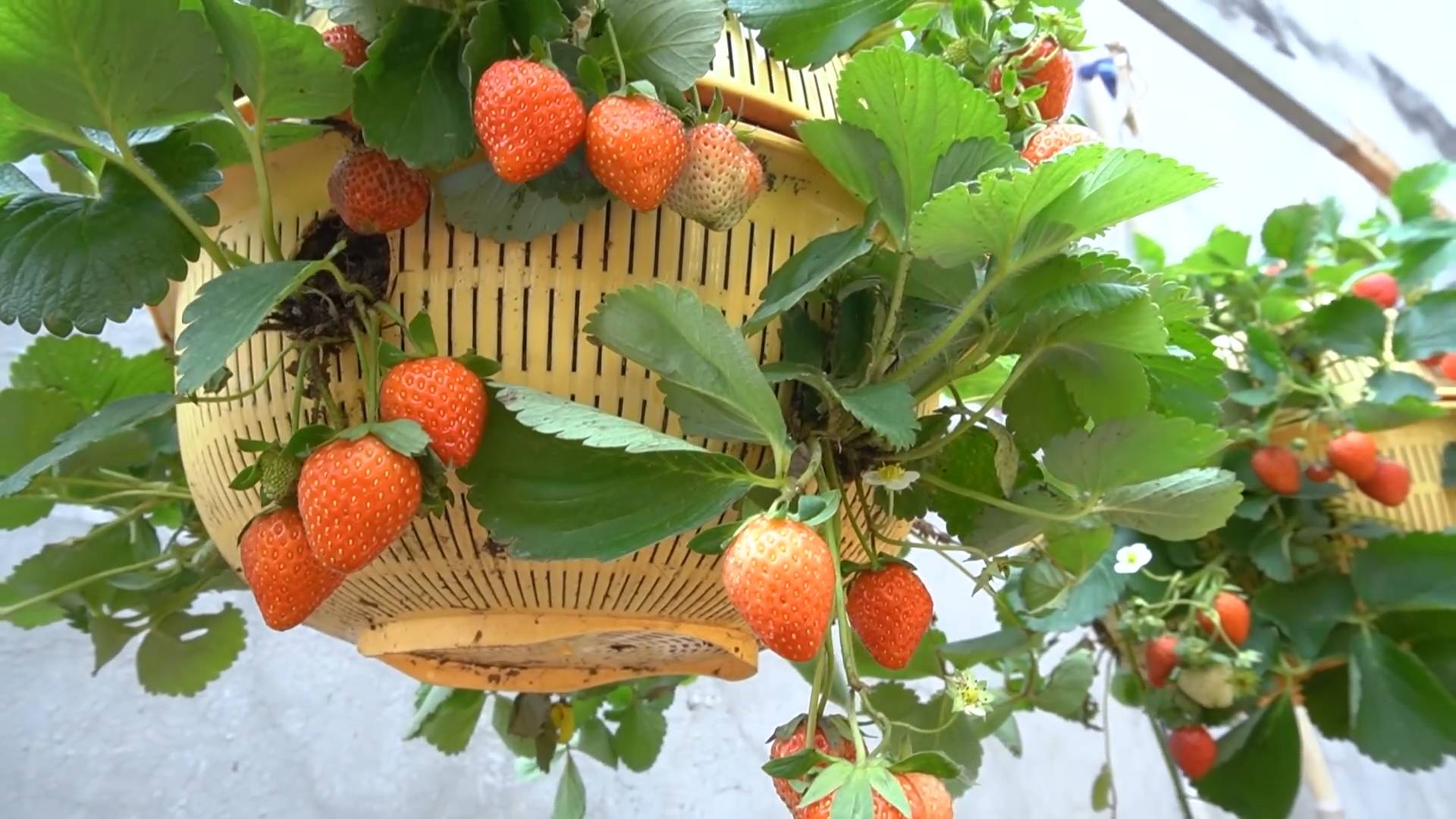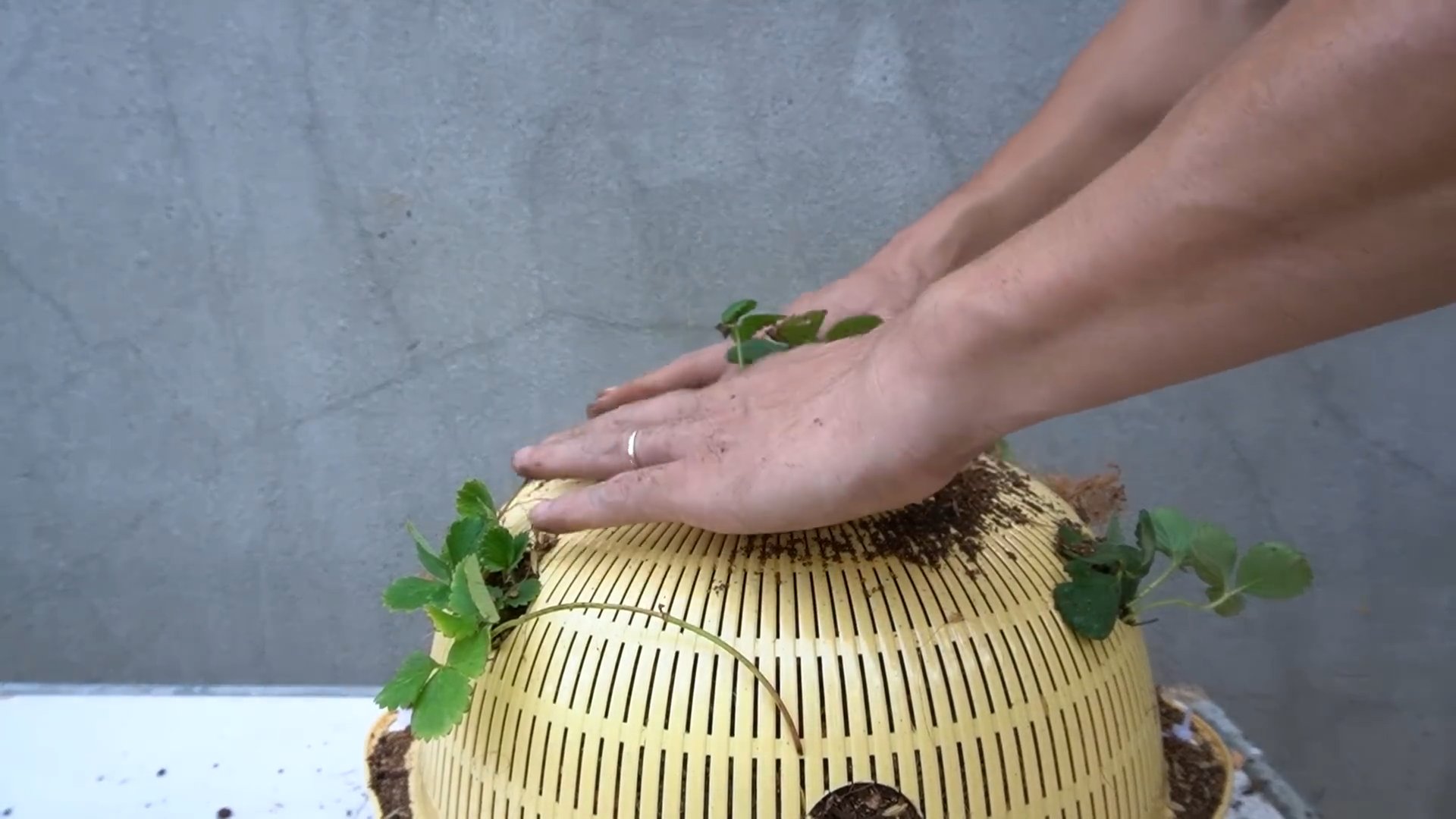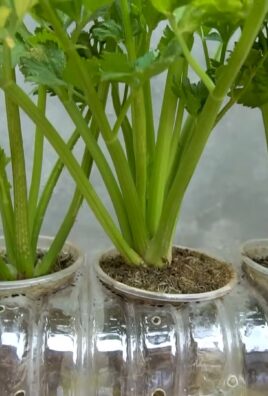Hanging strawberry baskets DIY projects are a fantastic way to bring a burst of color and deliciousness to your outdoor space, even if you’re short on ground! Imagine stepping onto your patio and being greeted by a cascade of vibrant green foliage dotted with juicy, red strawberries, all within easy reach. Sounds dreamy, right?
For centuries, people have cultivated strawberries in creative ways. From the elaborate strawberry pyramids of Victorian gardens to the simple clay pots used in ancient farming practices, the desire to grow these sweet berries close at hand is deeply rooted in our history. But let’s be honest, not everyone has the space for a sprawling strawberry patch. That’s where the magic of a hanging strawberry baskets DIY comes in!
I’m here to show you how to create your own stunning hanging strawberry baskets. This isn’t just about aesthetics; it’s about maximizing your yield, protecting your precious berries from pests, and adding a touch of personal flair to your home. Plus, who doesn’t love the satisfaction of growing their own food? In this article, I’ll guide you through a simple, step-by-step process, ensuring you have everything you need to create a thriving, beautiful, and bountiful hanging strawberry garden. Get ready to impress your neighbors and enjoy the sweetest, freshest strawberries you’ve ever tasted!

DIY Hanging Strawberry Baskets: A Sweet Treat for Your Garden
Hey there, fellow garden enthusiasts! I’m so excited to share one of my favorite DIY projects with you: creating beautiful and bountiful hanging strawberry baskets. Not only are these baskets a fantastic way to grow delicious strawberries, but they also add a touch of charm and vertical interest to any outdoor space, whether it’s a sprawling garden or a small balcony. Get ready to enjoy fresh, homegrown strawberries all season long!
What You’ll Need
Before we dive in, let’s gather all the necessary supplies. Trust me, having everything on hand will make the process so much smoother.
* Hanging Baskets: You can use wire baskets, plastic hanging pots, or even repurposed containers like old buckets or colanders. I personally love the look of wire baskets lined with coco coir liners. Aim for baskets that are at least 12 inches in diameter to give your strawberry plants enough room to grow.
* Coco Coir Liners (if using wire baskets): These liners help retain moisture and prevent soil from falling through the wire.
* Potting Mix: Use a high-quality potting mix specifically formulated for containers. Avoid using garden soil, as it can become compacted and doesn’t drain well in pots. I prefer a mix that includes peat moss, perlite, and vermiculite for optimal drainage and aeration.
* Strawberry Plants: Choose everbearing or day-neutral varieties for continuous fruiting throughout the season. June-bearing varieties produce a large crop all at once, which is great if you want to make jam, but everbearing and day-neutral are better for snacking. I usually get my plants from a local nursery to ensure they’re healthy and well-suited to my climate.
* Slow-Release Fertilizer: This will provide your strawberry plants with a steady supply of nutrients throughout the growing season. Look for a fertilizer specifically formulated for fruits and vegetables.
* Water-Absorbing Polymer Crystals (optional): These crystals help retain moisture in the soil, which is especially helpful in hanging baskets that tend to dry out quickly.
* Gloves: To protect your hands from dirt and potential irritants.
* Trowel or Small Shovel: For scooping and transferring potting mix.
* Watering Can or Hose: For watering your newly planted strawberries.
* Scissors or Utility Knife: For making drainage holes in plastic liners (if needed).
* Hanging Chain or Rope: To hang your baskets securely. Make sure it’s strong enough to support the weight of the basket, soil, and plants.
* Landscape Fabric or Burlap (optional): To create planting pockets on the sides of the basket.
Step-by-Step Instructions
Alright, let’s get our hands dirty and create these beautiful hanging strawberry baskets!
1. Prepare the Basket: If you’re using a wire basket, insert the coco coir liner. Make sure it fits snugly and covers the entire inside surface of the basket. If you’re using a plastic hanging pot, ensure it has adequate drainage holes. If not, carefully drill or cut a few additional holes in the bottom.
2. Add Potting Mix: Fill the basket about one-third full with potting mix. If you’re using water-absorbing polymer crystals, mix them into the potting mix according to the package instructions. This will help retain moisture and reduce the frequency of watering.
3. Incorporate Slow-Release Fertilizer: Sprinkle a layer of slow-release fertilizer over the potting mix, following the instructions on the fertilizer package. This will provide your strawberry plants with a steady supply of nutrients throughout the growing season.
4. Plant the First Layer of Strawberries: Now comes the fun part! Gently remove your strawberry plants from their containers, being careful not to damage the roots. Place the plants around the inside edge of the basket, spacing them evenly. The top of the root ball should be level with the top of the potting mix.
5. Add More Potting Mix: Add more potting mix to the basket, filling it up to about two-thirds full. Gently press down on the soil to remove any air pockets.
6. Plant the Second Layer of Strawberries (Optional): If you want to create a fuller basket, you can add a second layer of strawberry plants. Place these plants in the center of the basket, spacing them evenly. Again, the top of the root ball should be level with the top of the potting mix.
7. Fill the Basket with Potting Mix: Fill the basket completely with potting mix, leaving about an inch of space between the top of the soil and the rim of the basket. This will prevent water from overflowing when you water your plants.
8. Water Thoroughly: Water the newly planted strawberries thoroughly until water drains out of the bottom of the basket. This will help settle the soil and ensure that the roots are well-hydrated.
9. Attach Hanging Chain or Rope: Attach the hanging chain or rope to the basket, making sure it’s securely fastened.
10. Hang Your Basket: Choose a location that receives at least six hours of sunlight per day. Hang your basket in a sunny spot where you can easily access it for watering and harvesting.
Creating Planting Pockets (Optional)
If you want to maximize the number of strawberry plants in your hanging basket and create a truly stunning display, you can add planting pockets to the sides of the basket. Here’s how:
1. Cut the Landscape Fabric or Burlap: Cut several pieces of landscape fabric or burlap into squares that are large enough to cover the sides of the basket. The size of the squares will depend on the size of your basket.
2. Make Slits in the Liner: Using scissors or a utility knife, carefully make slits in the coco coir liner (or plastic liner) at even intervals around the sides of the basket. These slits should be large enough to accommodate the strawberry plants.
3. Insert the Fabric: Insert the corners of the landscape fabric or burlap squares into the slits, creating pockets on the sides of the basket.
4. Add Potting Mix to the Pockets: Fill each pocket with potting mix.
5. Plant the Strawberries: Gently remove the strawberry plants from their containers and plant them in the pockets. Make sure the roots are well-covered with potting mix.
6. Water Thoroughly: Water the newly planted strawberries thoroughly until water drains out of the bottom of the basket.
Caring for Your Hanging Strawberry Baskets
Now that your hanging strawberry baskets are complete, it’s important to provide them with proper care to ensure a bountiful harvest.
* Watering: Hanging baskets tend to dry out quickly, especially in hot weather. Water your strawberry plants regularly, checking the soil moisture daily. Water when the top inch of soil feels dry to the touch. Avoid overwatering, as this can lead to root rot.
* Fertilizing: Continue to fertilize your strawberry plants every few weeks with a balanced fertilizer. Follow the instructions on the fertilizer package.
* Sunlight: Strawberry plants need at least six hours of sunlight per day to produce fruit. Make sure your hanging baskets are located in a sunny spot.
* Pruning: Remove any dead or yellowing leaves from your strawberry plants. This will help prevent disease and encourage new growth.
* Pest Control: Keep an eye out for pests such as aphids, spider mites, and slugs. Treat any infestations promptly with an appropriate insecticide or organic pest control method. I personally prefer using neem oil for most pests.
* Harvesting: Harvest your strawberries when they are fully ripe and red. Gently twist the berries off the plant, being careful not to damage the stems.
* Winter Care: In colder climates, you’ll need to protect your strawberry plants from freezing temperatures. You can either bring the hanging baskets indoors or insulate them with burlap or straw.
Troubleshooting
Even with the best care, you might encounter a few challenges along the way. Here are some common problems and how to address them:
* Yellowing Leaves: This could be a sign of overwatering, underwatering, or nutrient deficiency. Check the soil moisture and adjust your watering schedule accordingly. Fertilize your plants with a balanced fertilizer.
* Lack of Fruit: This could be due to insufficient sunlight, poor pollination, or nutrient deficiency. Make sure your plants are getting at least six hours of sunlight per day. You can also hand-pollinate the flowers by gently brushing them with a small paintbrush. Fertilize your plants with a fertilizer specifically formulated for fruits and vegetables.
* Pests: Inspect your plants regularly for pests and treat any infestations promptly.
* Root Rot: This is caused by overwatering and poor drainage. Make sure your hanging baskets have adequate drainage holes and avoid overwatering.
Enjoy Your Harvest!
With a little bit of care and attention, your hanging strawberry baskets will reward you with a delicious and abundant harvest. Imagine plucking fresh, juicy strawberries right from your own garden – it’s a truly satisfying

Conclusion
So, there you have it! Creating your own hanging strawberry baskets is not just a cost-effective alternative to buying pre-made ones; it’s a rewarding experience that connects you with nature and allows you to customize your garden to your exact preferences. We’ve walked you through the simple steps, highlighting the ease and accessibility of this project. But why is this DIY trick a must-try?
Firstly, the satisfaction of nurturing your own food from seedling to harvest is unparalleled. Imagine plucking ripe, juicy strawberries, grown with your own hands, right from your hanging basket. The taste is simply superior to anything you can buy in a store. Secondly, you have complete control over the materials used. Opt for organic soil and fertilizers to ensure the healthiest and most delicious berries. This is especially important if you are conscious about what you consume.
Beyond the practical benefits, hanging strawberry baskets add a touch of charm and visual appeal to any space. Whether you have a sprawling garden, a small balcony, or even just a sunny windowsill, these baskets bring a vibrant splash of green and red. They are a conversation starter, a testament to your creativity, and a source of pride.
Now, let’s talk about variations. Feel free to experiment with different types of containers. While we’ve focused on traditional hanging baskets, you can also use repurposed buckets, old tires (painted and properly prepared, of course!), or even fabric grow bags. The key is to ensure adequate drainage and sufficient space for the strawberry plants to thrive.
Consider companion planting to enhance your strawberry yield and deter pests. Marigolds, basil, and thyme are excellent choices to plant alongside your strawberries. They not only add beauty to your hanging baskets but also provide natural pest control.
Another exciting variation is to create a tiered hanging strawberry garden. By stacking multiple baskets of different sizes, you can create a stunning vertical display that maximizes space and adds a dramatic focal point to your garden.
Don’t be afraid to get creative with the design of your hanging baskets. Add decorative elements such as ribbons, painted designs, or even small trellises for the strawberry plants to climb. The possibilities are endless!
The most important thing is to have fun and enjoy the process. Gardening should be a relaxing and fulfilling activity. So, gather your supplies, follow our simple steps, and get ready to enjoy a bountiful harvest of delicious, homegrown strawberries.
We are confident that you will find this DIY project both enjoyable and rewarding. We encourage you to try this hanging strawberry baskets DIY project and share your experience with us! Post pictures of your creations on social media using #DIYStrawberryBaskets and tag us so we can see your amazing work. We can’t wait to see what you come up with! Happy gardening!
Frequently Asked Questions (FAQ)
What type of strawberries are best for hanging baskets?
Day-neutral and everbearing strawberry varieties are generally recommended for hanging baskets. Day-neutral varieties produce fruit throughout the growing season, while everbearing varieties produce two main crops – one in the spring and another in the fall. Some popular choices include ‘Tristan’, ‘Tribute’, ‘Seascape’, and ‘Albion’. These varieties tend to be compact and produce a good yield of flavorful berries. Avoid June-bearing varieties, as they produce a large crop all at once, which may not be ideal for the limited space of a hanging basket.
How often should I water my hanging strawberry baskets?
Hanging baskets tend to dry out quickly, especially during hot weather. Check the soil moisture daily by sticking your finger about an inch into the soil. If the soil feels dry, it’s time to water. Water thoroughly until water drains out of the bottom of the basket. Avoid overwatering, as this can lead to root rot. In general, you may need to water your hanging strawberry baskets once or twice a day during the peak of summer.
What kind of soil should I use for my hanging strawberry baskets?
Use a high-quality potting mix that is well-draining and rich in organic matter. Avoid using garden soil, as it can be too heavy and may not drain properly. A good potting mix will provide the necessary nutrients and aeration for healthy strawberry plant growth. You can also amend the potting mix with compost or other organic materials to further improve its fertility.
How much sunlight do hanging strawberry baskets need?
Strawberries need at least 6-8 hours of direct sunlight per day to produce a good crop of berries. Choose a location for your hanging strawberry baskets that receives plenty of sunlight. If you live in a hot climate, provide some afternoon shade to prevent the plants from overheating.
How do I fertilize my hanging strawberry baskets?
Strawberries are heavy feeders and require regular fertilization to produce a bountiful harvest. Use a balanced fertilizer specifically formulated for strawberries or fruits and vegetables. Follow the instructions on the fertilizer package for application rates and frequency. You can also use organic fertilizers such as compost tea or fish emulsion. Fertilize your hanging strawberry baskets every 2-3 weeks during the growing season.
How do I protect my hanging strawberry baskets from pests and diseases?
Regularly inspect your strawberry plants for signs of pests or diseases. Common pests that affect strawberries include aphids, spider mites, and slugs. Diseases such as powdery mildew and gray mold can also be a problem. Use organic pest control methods such as insecticidal soap or neem oil to control pests. Ensure good air circulation around the plants to prevent diseases. Remove any infected leaves or berries promptly. You can also use row covers to protect your plants from pests and diseases.
How do I overwinter my hanging strawberry baskets?
In colder climates, you will need to overwinter your hanging strawberry baskets to protect the strawberry plants from freezing temperatures. There are several ways to do this. You can bring the baskets indoors and place them in a cool, sunny location. Water sparingly during the winter months. Alternatively, you can insulate the baskets by wrapping them in burlap or bubble wrap. Place the baskets in a sheltered location, such as a garage or shed. Water occasionally to prevent the soil from drying out completely. In the spring, gradually acclimate the plants to outdoor conditions before placing them back in their original location.
Can I grow other plants in the same hanging basket as strawberries?
Yes, you can grow companion plants with strawberries in the same hanging basket. Some good companion plants for strawberries include marigolds, basil, thyme, and borage. These plants can help to deter pests, attract beneficial insects, and improve the flavor of the strawberries. Avoid planting aggressive plants that may compete with the strawberries for nutrients and water.
How long will my strawberry plants last in a hanging basket?
Strawberry plants typically last for 3-5 years in a hanging basket. However, their productivity may decline after the first few years. To maintain a good yield, it is recommended to replace your strawberry plants every 2-3 years. You can propagate new strawberry plants from runners produced by the existing plants.
What do I do with the runners that my strawberry plants produce?
Strawberry plants produce runners, which are long stems that grow horizontally from the main plant. These runners will develop roots and form new strawberry plants. You can either allow the runners to root in the same hanging basket or transplant them to new pots or hanging baskets. To transplant a runner, simply cut it from the mother plant after it has developed roots. Plant the new plant in a well-draining potting mix and water thoroughly.




Leave a Comment